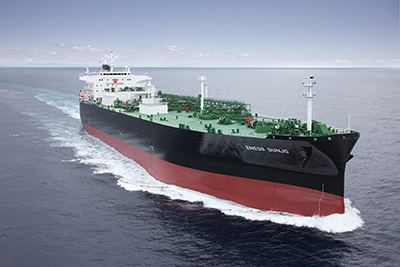Delivery of the LPG-powered “ENEOS GUNJO ” LPG/NH3 Carrier
Sep. 29, 2023

Tokyo, September 29, 2023 — Kawasaki Heavy Industries, Ltd. announced today its delivery of the “ENEOS GUNJO ” (Kawasaki hull no. 1757), an 86,700 m3 liquefied petroleum gas (LPG) and ammonia (NH3) carrier powered by LPG.
The “ENEOS GUNJO ” is the second of Kawasaki’s newest-design 86,700 m3 capacity, LPG-fueled LPG/NH3 carrier, with the increased cargo capacity from the existing 84,000m3 LPG Carrier as well as ammonia loading capability. As for LPG-powered vessels, Kawasaki has completed eight vessels to date, and the “ENEOS GUNJO ” is its 72nd LPG carrier in total.
This carrier is equipped with separate cargo tanks and has a capability of simultaneous transportation of LPG, which is already widely used as a low-carbon-emission energy source, and ammonia, which may be expected to be utilized as a new fuel in the low- and zero-carbon-emission societies. Furthermore, this vessel is designed to increase cargo tank capacity, with keeping its principal dimensions like LOA and beam similar to conventional-type vessels so that the carrier can be berthed at major LPG terminals around the world.
In consideration of the strengthening of environmental regulations around the world and action plans for the Sustainable Development Goals (SDGs), Kawasaki will continue to develop and provide customers with environmental-friendly ship technologies with a focus on LPG carriers and LPG/NH3 carriers powered by LPG, as well as other types merchant vessels in comply with the latest environmental regulations,— including liquefied hydrogen carriers, the cargo of which is expected to be a fuel that is gaining popularity as a next-generation energy source. In this way, Kawasaki will contribute toward the realization of low- and zero-carbon-emission societies.
| Specifications | |
|---|---|
| Length overall | 229.90 m |
| Molded breadth | 37.20 m |
| Molded depth | 21.90 m |
| Molded draft | 11.65 m |
| Speed | Approx. 17.0 knots |
| Crew complement | 29 |
| Gross tonnage | 49,541 T |
| Deadweight | 56,531 t |
| Cargo tank capacity | 86,904 m3 |
| Main engine | One set of Kawasaki-MAN B&W 6G60ME-C10.5-LGIP diesel engine |
| Classification/country of registration | Nippon Kaiji Kyokai (ClassNK) / Panama |
| Delivery date | September 29, 2023 |
Features
- This carrier is equipped with the Kawasaki-MAN B&W 6G60ME-C10.5-LGIP, a Kawasaki-made, electronically controlled, LPG-injection marine diesel engine (ME-LGIP engine). By utilizing LPG as fuel, it is possible to significantly reduce sulfur oxide (SOx) and CO2 emissions in exhaust gases compared with ships running on conventional marine fuel oil, enabling compliance with SOx emission standards*1 and EEDI phase 3 regulations.*2
- The propulsion system is compliant with nitrogen oxide (NOx) Tier III requirements*3 and utilizes EGR*4 and SCR*5 equipment. Thanks to this system, the vessel is able to travel in NOx emission control areas (ECAs) even when operating on conventional low-sulfur fuel.
- Fuel consumption amounts are reduced through the inclusion of the Kawasaki RBS-F (Rudder Bulb System with Fins), the Kawasaki SDS-F (Semi-Duct System with contra Fins), and energy-saving fins around the propeller.
- The concept design for a system that utilizes ammonia as fuel on this vessel has been approved by Nippon Kaiji Kyokai (ClassNK). Therefore, it is possible to modify ship design specifications to enable the use of ammonia as fuel in the future.
Remarks
| *1 | SOx emission standards: Since January 2015, International Maritime Organization (IMO) SOx emission restrictions in North American and European ECAs have limited sulfur content in fuels to 0.1% or less. Starting in January 2020, regulations have required ships operating in all other parts of the world to use fuel with sulfur content levels of 0.5% or less, or alternatively use equipment to reduce SOx in exhaust gases to an equivalent level. |
| *2 | Energy Efficiency Design Index: Compulsory international regulations requiring energy-efficiency compliance in newly built ships based on EEDI values, which specify CO2 emissions in grams for transporting one ton of cargo for one mile. EEDI regulation values apply in increasingly strict phases based on the construction-contract conclusion date and finished-ship delivery date. Phase 3 regulations (30% CO2 emissions reduction compared with baseline levels) apply for certain ship types, including large LPG carriers and LNG (liquefied natural gas) carriers, contracted to be built in 2022 or later. |
| *3 | NOx emission standards: The IMO regulates ship NOx emissions. Tier III regulations, which were enacted in 2016, specify controls for North American and European ECAs only, and stipulate an 80% NOx reduction over the Tier I value. |
| *4 | Exhaust gas recirculation: An EGR system cleans a portion of exhaust gases using wash water and recirculates them as air for use in the combustion process within the propulsion system. This reduces oxygen concentrations in combustion air and lowers combustion temperature, mitigating the oxidation reaction of nitrogen at high temperatures to reduce resulting NOx emissions. The water used to clean the exhaust gases is treated to remove soot, oils and other contaminants, rendering it safe before its release into the sea outside the vessel. |
| *5 | Selective catalytic reduction: The SCR system sprays urea water into high-temperature exhaust gases from the generator, decomposing the ammonia contained therein. By using this together with catalysts such as titanium and vanadium, it is possible to trigger a reaction with the NOx in exhaust gases, converting them into nitrogen and water and thus reducing NOx emissions. |
Relevant links
Kawasaki Super Green Products (LPG Powered Large LPG Carrier)
https://global.kawasaki.com/en/corp/sustainability/environment/consideration/pdf/item_2021_14_e.pdf
Energy-saving Technology
https://global.kawasaki.com/en/mobility/marine/technology/energy_saving.html
Contact
If you need more information about our business,
please feel free to contact us.





